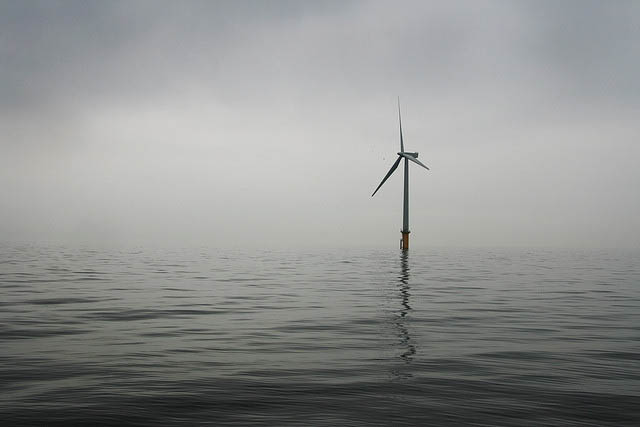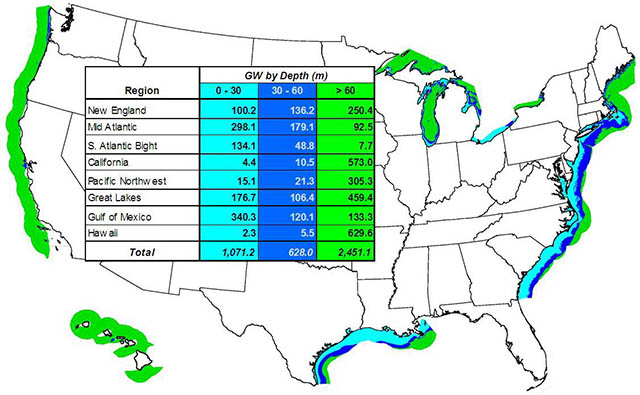Even though records were broken last year in wind power installations, the rate of growth continued to decline compared to previous years. Offshore wind power was unfortunately, with the exception of a small handful of nations, a sideshow to onshore wind power.
This is particularly striking in the United States, which has the second-largest amount of wind power installed in the world and virtually tied for most new installations last year, where there still is not a single completed offshore wind farm—even though there are several planned, including the over-a-decade-in-the-works Cape Wind.

A Fraction of a Fraction of Power Generation
Global offshore wind power, at the end of 2012, totals 5.4 gigawatts, concentrated, with but two exceptions, in Europe. For comparison, total global wind power capacity now tops 282 GW; new installations alone last year were nearly 45 GW.
Though the United Kingdom ranks sixth in terms of overall wind power capacity, with 8.5 GW, it leads the world in offshore wind power by a huge margin—not surprising considering it’s an island nation, with very high population density (which loves the countryside as is, right or wrong), and an ancient connection with the sea. Last year the UK installed a bit over 850 MW of offshore wind power, bringing the national total to 2.95 GW.
The second-ranked nation, Denmark, trails far behind, with a total of 921 MW of offshore wind power, just 47 MW installed new last year. China occupies the third spot, with 390 MW (in two projects), 127 MW new for 2012. Belgium, Germany, and Netherlands round out fourth through sixth places—as well as being the only other nations with over 200 MW of offshore wind power.
As you go deeper into the rankings, it becomes slightly absurd: Though in an absolute sense both Norway and Portugal have some offshore wind power capacity, it’s so low (2.3 MW and 2 MW respectively) that it begs the question if a project having under five turbines really counts as a commercial wind farm, except in a technical sense that it does generate power for money.
Currently the three largest offshore wind power project are, not surprisingly, in the UK: The 504 MW Greater Gabbard wind farm, 367 MW Walney Wind Farm and the 300 MW Thanet project.
Much larger projects are in the works though, and frankly have been since what seems like forever. Projects in various stages of completion just topping the two UK projects above, going all the way up to the 1000 MW London Array, always seem to be just a little while longer away from completion. Truly massive, multi-gigawatt projects have been proposed for the North Sea, but these are a ways off.
US in Second Place Overall, But Offshore Projects Languish
In the US though, beyond no offshore wind power project being completed, very little even approaching this scale is even being contemplated—even though reports have shown that offshore wind power alone could power the entire East Coast.
A sampling of projects currently at one stage or another of planning or proposal: A 30 MW project off Block Island (maybe one day accompanied by another by the same developer, farther out to sea, with a 900-1200 MW capacity, maybe), a project off the coast of Maryland (currently on hold), a 12 MW project off Texas, a 20 MW project in Lake Erie (yes, offshore wind power can mean freshwater, too).
And then there’s Cape Wind. Began over a decade ago, and subject to one of the most intense back and forth battles for approval, the 24 square mile project in Nantucket Sound is planned to have 130 3.6 MW turbines. It’s currently the only offshore wind power project in the US to have all its permitting in place. The most recent estimate for completion is for it to first starting producing electricity in 2015, with it coming to full capacity in 2016.
For over a year now, the Obama administration, acting through the Department of Interior (which handles resources on the continental shelf), has technically fast-tracked offshore wind power development, streamlining offshore wind power approval off New Jersey, Maryland, Delaware, and Virginia.
At the time Kit Kennedy summed up the situation for NRDC Switchboard. Though a year old, it pretty much still stands as an accurate assessment:
“The process for getting offshore wind power off the ground in this country takes far too long. The projected timeline for approval of an offshore wind project is currently 7-9 years, far longer than the typical siting process for a fossil fuel power plant (2-3 years). It’s a crying shame that it has taken so long to get clean, homegrown offshore wind turbines up and running while fossil fuel power plants, with their plethora of health and environmental impacts, can be green-lighted in a fraction of the time.”

As for the potential for offshore wind power in the US waiting to be tapped, check out the chart above. Adding that all up, tallying the potential at different water depths, it’s 4,180 GW—more theoretical potential than all of the US’s current electricity capacity from all sources by a factor of four. Even taking into consideration that the far right column involves putting turbines into water depths greater than is currently done, it’s still more power than is currently generating.
Here’s the really sobering part (or encouraging part, depending on your mood): Wind power right now provides just 3.46% of all the electricity generated in the US. So little, but so so much room for expansion—and reduced environmental impact.